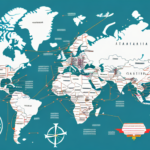6 Tips for Successful International Ecommerce
1. Conduct Comprehensive Market Research
To thrive in the international ecommerce landscape, businesses must begin with thorough market research. This involves analyzing consumer behavior, understanding local competition, and assessing economic conditions in target markets. Utilizing tools like Google Market Finder can provide valuable insights into potential markets by offering data on market size, growth rates, and consumer preferences.
Understanding the preferred payment methods in different regions is crucial. For instance, while credit cards dominate in the United States, digital wallets like Alipay and WeChat Pay are more prevalent in China. Tailoring payment options to local preferences can significantly enhance transaction completion rates.
2. Localize Your Ecommerce Strategy
Localization goes beyond simple translation. It involves adapting your website, marketing materials, and customer service to align with the cultural nuances of each target market. This includes adjusting language, imagery, and even product offerings to resonate with local audiences.
Investing in professional translation services ensures that product descriptions and marketing copy are not only accurate but also culturally relevant. Tools like Gengo can assist in providing high-quality translations that maintain the brand’s voice.
3. Optimize Payment Methods and Currency Options
Offering a variety of payment options tailored to local preferences can significantly increase sales. According to a 2023 report by PYMNTS, consumers are more likely to complete purchases when their preferred payment method is available.
- Credit and Debit Cards: Widely accepted globally, but preferences can vary by region.
- Digital Wallets: Platforms like PayPal, Apple Pay, and regional favorites like Paytm in India.
- Bank Transfers: Preferred in certain European countries for their security and reliability.
Additionally, displaying prices in local currencies can reduce hesitation caused by exchange rate fluctuations and additional fees. Implementing a multi-currency pricing strategy can enhance the shopping experience and build customer trust.
4. Select the Right International Shipping Solutions
Efficient and reliable shipping is a cornerstone of successful international ecommerce. Partnering with reputable logistics providers like DHL or UPS can ensure timely deliveries and handle customs clearance effectively.
Consider the following when selecting shipping options:
- Shipping Costs: Compare rates from different carriers to find the most cost-effective solutions without compromising on service quality.
- Delivery Times: Aim to offer competitive delivery speeds to meet customer expectations.
- Tracking Capabilities: Providing real-time tracking can enhance transparency and customer satisfaction.
Implementing flexible shipping options, such as express and economy shipping, can cater to diverse customer needs and preferences.
5. Ensure Legal and Regulatory Compliance
Operating internationally requires adherence to various legal and regulatory standards. This includes understanding and complying with tax laws, customs regulations, and data protection laws like the General Data Protection Regulation (GDPR) in the European Union.
Work with local legal experts or consult resources from organizations such as the International Trade Administration to ensure compliance. Non-compliance can result in hefty fines and damage to your brand’s reputation.
Additionally, ensure that your website complies with local consumer protection laws, which may dictate return policies, warranty information, and mandatory disclosures.
6. Leverage Effective Global Marketing Strategies
Marketing strategies must be tailored to resonate with each target market. Utilizing social media, search engine optimization (SEO), and content marketing can drive traffic and build brand awareness globally.
- Social Media Marketing: Platforms like Facebook, Instagram, and regional favorites such as WeChat in China or VKontakte in Russia, can be powerful tools for engagement.
- SEO: Optimize your website for local search engines by incorporating relevant keywords and adhering to regional SEO best practices.
- Content Marketing: Create localized content that addresses the unique needs and interests of your international audience.
According to a 2023 HubSpot report, businesses that invest in localized marketing strategies witness a 67% higher conversion rate compared to those that do not.
Conclusion
Expanding into international markets presents immense opportunities for ecommerce businesses. By conducting comprehensive market research, localizing strategies, optimizing payment and shipping options, ensuring legal compliance, and leveraging effective marketing techniques, businesses can navigate the complexities of international ecommerce successfully. Embracing these strategies will not only enhance global reach but also drive sustained growth and profitability.






















